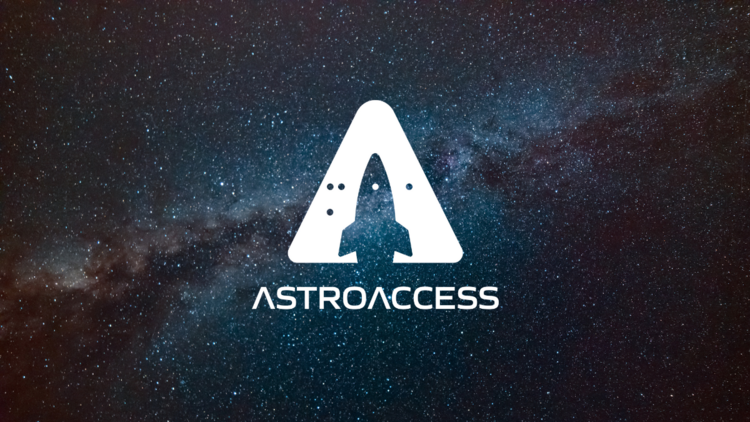History & Culture
A Giant Step for Humanity: Making Space Accessible
The promise of space travel should be available to everyone.
By Elisa Shoenberger
AstroAccess Ambassadors Denna Lambert (left), Victoria Garcia (center), Dr. K Renee Horton (right), float in zero-gravity.
Image Credit: Zero-G / Tasha Dixon / AstroAccess Flight 2"
Paralympians made headlines in late summer 2024 while competing in the Paris Paralympic Games—showing incredible feats of athleticism, breaking records, and winning medals. In the Games’ Opening Ceremonies, former Paralympic Bronze medalist and orthopedic surgeon, John McFall, carried the Paralympic flag. He may be breaking a new record as well: being the first person with disabilities to go into outer space.
In 2022, the European Space Agency (ESA) selected McFall to be part of its Fly! Program. The Fly! feasibility study, according to a ESA press release, “aims to make long-duration space missions accessible for those with a range of physical abilities by tackling challenges such as microgravity adaptation, physical fitness and rehabilitation and technology integration.”
ESA reported on McFall’s Fly! participation just two years later that the “para-astronaut’s training” had “demonstrate[d] that it would be technically feasible for an astronaut with a physical disability to travel to space.” While it is exciting to see McFall’s success, more progress is needed to make space truly open to people of all abilities.
Such progress is underway on multiple fronts, including one by AstroAccess, a project begun in 2021 that is dedicated to promoting disability inclusion in space exploration. Explains Zach Damon, the Media Relations Manager for AstroAccess in a personal interview: “We’re thrilled with the ESA’s Fly! feasibility study and John McFall's selection. It’s a significant step forward, though just the beginning.”
A Cultural Construct
While ESA began its Fly! feasibility study in 2022, the National Aeronautics and Space Administration (NASA) has conducted studies using people with disabilities as far back as the 1950s. The most famous program, known as the “Gallaudet Eleven,” featured eleven Deaf men who were from Gallaudet College (now Gallaudet University). In a personal interview with University of Chicago space historian and science communication professor Jordan Bimm, there were also some women in the program but not part of the famous “Eleven.”
Aware that inner ear functions in Deaf individuals can be essentially shut off, investigators conducted a joint program between NASA and the U.S. Naval School of Aviation Medicine to study whether people who are Deaf have the same issues with disorientating effects of weightlessness and zero-G as those who are non-Deaf.
What had been observed among astronauts was that most suffer from a type of disorienting space sickness, or “Space Adaptation Syndrome,” during their first few days in space. Such space sickness is basically motion sickness: the liquid in the inner ear floats in zero-G gravity, and this confuses the brain.
The test subjects went through a variety of scenarios meant to mimic zero-G including zero-G flights nicknamed the “Vomit Comet.” In 2017, NASA published an article about the Gallaudet Eleven noting that one experiment was “conducted in a ferry off the coast of Nova Scotia, tested the subjects’ reactions to the choppy seas. While the test subjects played cards and enjoyed one another’s company, the researchers themselves were so overcome with sea sickness that the experiment had to be canceled.” The same article noted that the test subjects enjoyed the experience and were not impacted by the zero-G forces, unlike their hearing counterparts.
Bimm noted that this experiment, among other studies, suggests that “our categories of ability and disability are culturally constructed and historically contingent.” In other words, it depends on the environment and ability. The Gallaudet Eleven was, according to Bimm, a “sort of tacit realization amongst some people in the field of space medicine, that people who are just disabled in our sort of terrestrial paradigm may actually be more able in the space environment.”

Left Image
AstroAccess Ambassadors Larry Guterman (left) and Brenda Williamson (right).
Courtesy of Blaga Ditrow / Zero Gravity Corporation.
Right Image
AstroAccess Ambassador Kyle Horn (center) in Zero-Gravity.
Courtesy of Aurelia/MIT Space Exploration Initiative
Over the subsequent decades, compelling arguments have been made that people with disabilities may have certain advantages over other people with terrestrial-able bodies. In a 2018 opinion piece for Scientific American, Sheri Wells-Jensen, associate professor of English at Bowling Green State University, wrote, “in life-or-death situations, the presence of a crew member who attends to non-visual cues could save lives.”
Wells-Jensen explained that, in 1997, the Russian Mir space station had a fire that enveloped the station in so much smoke and darkness that the cosmonauts on board had difficulty finding the fire extinguisher. If there had been a blind astronaut onboard, they “would not be bothered by either dim lighting or occluding smoke. She would accurately direct the fire extinguisher at the source of heat and noise.”
Other people with differently shaped bodies may also have other advantages over the stereotypical cis-male adult body. In the 2023 WIRED article, “Why Aren’t Disabled Astronauts Exploring Space?” Ashley Shew, associate professor of science, technology, and society at Virginia Tech, wrote: “I learned that short women with larger thighs do better at not passing out when they pull high numbers of g’s as fighter pilots; their brains are closer to their hearts, so the additional blood flow helps them remain conscious, and their larger butts/thighs seem to absorb some impact. Yet typically, the ‘best’ fighter pilot looks like Val Kilmer as Iceman in Top Gun.”
Anna Voelker, project lead of AstroAccess and founder and Executive Director of SciAccess, Inc, pointed out other benefits in a 2023 interview with ZME Science at the Falling Walls Science Summit in Berlin. Sign language could be incredibly useful should people’s audio communications systems go out. Missing a leg or below-waist paralysis may be a significant disadvantage on Earth but “in a zero-gravity environment it gets canceled out because there is no walking—you’re just floating,” she explained.
Voelker is part of the charge to show how differently abled people can be successful in space. AstroAccess has been “dedicated to promoting disability inclusion in human space exploration by paving the way for disabled astronauts.” Since 2021, they’ve run several parabolic flights, which simulate zero-gravity, with people with disabilities.
AstroAccess Ambassadors Mary Cooper (back row, left), Sheri Wells-Jensen, Eric Shear, Apurva Varia, Sina Bahram, Zuby Onwuta, Mona Minkara Viktoria Modesta. (front row, left) Sawyer Rosenstein, Dana Bolles (center), Eric Ingram, and Centra (Ce-Ce) Mazyck (right).
Courtesy of AstroAccess.
For the Better of Humankind
While we rethink what disability means in space and on Earth, making space available to people of different shapes and abilities benefits everyone. As AstroAccess’s Voelker said, “If we can make space accessible, we can make any space accessible.”
Zach Damon, AstroAccess Media Relations Manager explained in a personal email interview: “We must not leave behind 15% of the global population, including talented scientists, engineers, and researchers, due to outdated restrictions. The commercial space sector misses out on a large customer base since 1 in 4 Americans has a disability. Accessible workplaces outperform peers, proving that inclusion fosters innovation and productivity.”
On top of that, AstroAccess’s test flights have evaluated various equipment and access solutions, such as American Sign Language (ASL) comprehensive, tactile graphics and more that they have been invited to share with NASA, SpaceX, and Blue Origin, Damon explained. “Our work highlights that accessible design enhances safety for everyone, not just those with disabilities.” For instance, sighted astronauts can benefit from tactile graphics just as much as blind astronauts can as well.
Making space fully accessible will also be living out the promise of space exploration. Since the start of the Space Age, historian Bimm stated in a personal interview that rhetoric around space exploration and travel has been that it would benefit everyone. “I would hope that the reality matches that rhetoric, and it really is for everyone,” he said.
On top of that, Bimm noted that, since so much of space exploration is often tied to the future of humanity, who can go to space is “by proxy an estimation of who is really right or wrong for the species. When you set up this filter at the edge of the planet that is very blist and has a sort of long history of quasi-eugenics, you see a disconnect.”
A Mindset Change
Another critical factor is that space is not suited for any human bodies. Prolonged time in space can actually cause disability—whether from bone density loss to swelling of the optic nerve—and people who are able-bodied on Earth may become disabled due to their time in space. This will have a significant impact on long-distance space travel.
We should consider as well that, “We’re going to see more and newer forms of disability in the future,” Ashley Shew, associate professor of science, technology, and society at Virginia Tech wrote in the 2023 WIRED article, “We need to prepare for the disabled future: becoming more comfortable with other people’s disabilities, accepting the fact that we ourselves will eventually be disabled (if we aren’t already), learning to recognize and root out ableism.
Thankfully, space is set up to be more accessible than one might expect. AstroAccess’s Damon noted that, “many of the design changes that need to be made are minor, and that the real challenge is to change policy and procedures, challenging past conceptions of ‘the right stuff,’” referencing Tom Wolfe’s famous 1979 novel, The Right Stuff, which was made into a movie with the same name.
Some minor changes would include tactile braille and LED lighting systems around the spacecraft, which AstroAccess already tested in their zero-gravity trials. Damon also mentioned spacesuits “could be redesigned to include gloves that allow for better dexterity, improving communications for deaf astronauts using sign language, while benefiting maneuverability for all. Spacesuits could also integrate advanced hearing technology, enabling astronauts to customize audio levels according to their hearing preferences and the surrounding environment.”
Advances in medicine are also making significant inroads to providing medical care in space. For instance, Virtual Incision, with its mission to miniaturize robotic surgery, has conducted promising trials with its MIRA Surgical System, which potentially will allow for long-distance surgery. The idea is that if there is an emergency for a crewmember who cannot be evacuated in time to Earth, ship personnel could set up MIRA on the ship in space and have doctors on Earth conduct the surgery virtually, ensuring the crewmember receives the medical care they need.
Not only does this have great implications for space exploration, but MIRA could provide significant medical access to remote, Earth-bound communities or communities without enough surgeons. Of course, MIRA is still being tested; late in 2024, Virtual Incision reported “the successful completion of a preclinical demonstration of nearly 40,000-miles combined distance. Four surgeons performed a total of 20 procedures on porcine models as part of the remote capabilities test, representing approximately 2,000 miles for each procedure.” Such technology could also open up space for people who may be disqualified from travel off-planet because of chronic diseases, systems such as MIRA providing a failsafe medical option.
Ultimately, these accessible changes should be “disability-led and fully incorporate the perspectives and lived experiences of members of the disability community,” stated Damon. “For example, we don’t need to problem solve for where a wheelchair goes in a spacecraft, because there is no gravity.”
But with all the technology and adaptations in the world, it will not matter if leaders of companies and government agencies do not change their mindset about what kind of person can be an astronaut. Bimm explained that when it comes to technological problems, there is “endless enthusiasm to resolve that technological problem.” He cited the emergency situation that arose in 1970 on Apollo 13: NASA scientists had to figure out how to make a square peg fit into a round hole within 24 hours or the astronauts would have suffocated. But “when the problem is the human body for some reason, there is a glaring asymmetry in enthusiasm for problem solving,” he noted.
While ESA’s Fly! feasibility project is promising with para-astronaut McFall, Damon said, “[i]t’s a significant step forward, though just the beginning. It's important to note that ‘astronaut’ should be the standard term, without caveats like ‘para’ or ‘disabled.’” On top of that, there have been concerns expressed about whether McFall’s prosthetics would be toxic on the spacecraft. While this is not something to ignore, it seems like there is a huge focus on this aspect of McFall’s training compared to all of the progress he has been making. After all, if a square peg can go into a round hole, can someone not come up with a “safer” prosthetic?
Now is the time to make space truly accessible to all humankind. Damon aptly stated: “The future of space travel is not just about reaching new frontiers, it's also about doing so in a way that includes everyone, ensuring that our journey is as innovative, resilient, and inclusive as possible.”
Elisa Shoenberger is a writer and freelance journalist in Chicago. She has written for WIRED Magazine, Boston Globe, Huffington Post, Slate, and Business Insider.
Mercury is an advertisement-free publication. If you are interested in supporting Mercury, please email us.




